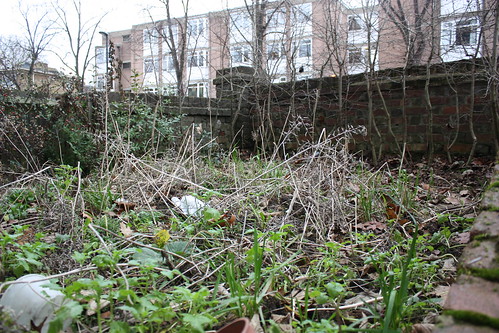
s sworn by myself, the current situation of the `garden'. It is at this point necessary to say I'm not sure I can call myself a gardener anymore - more someone who happens to own a garden. First up, the rarely photographed and much maligned front garden. It's always been an issue, since before we even moved in. The builders/cowboys dumped all the rubble on it and compacted the earth, destroying any vestiges of plant life in the process. As with the back garden we inherited scrubland, but with two fatal flaws: firstly, there's a lot of clay in this patch that's almost impossible to dig; secondly and probably more importantly, as it's on the street it's not a nice place to work - one feels very exposed.

he hedge at the back is the hawthorn hedge we planted 4 years ago, and it grows well. Two summers ago we fought with the clay and grew potatoes to keep the weeds down and break up the soil. It was about 50% successful. This summer we sowed green manure to try and break up the soil more. I'm not convinced it worked at all, but the remains of this sowing is what you can see now because we never had time (or inclination) to dig it in. Dan's idea is to build raised beds and add compost/topsoil/grit over the top. A good suggestion, but I'm worried this will effectively created a clay-pot under whatever we plant and stop them becoming established. Beds would be separated by small paths so we can walk around the square easily, established using membrane dressed with slate, gravel, wood-chip or similar. Also a good idea, but I'm inherently mistrustful of membrane (as is Dan). It's an easy solution to keep the weeds down to be sure, but I dislike the artificial separation between earth and sky it creates. On the other hand, this is basically central London so my feelings on the matter are probably irrelevant; this patch of earth exists surrounded by brick and concrete, if it looked less abandoned it would know doubt be a win for all passersby and it's certainly not supporting much wildlife right now. Opinions?


Do you really want to grow vegetables? How much would you really be able to grow - a handful or so to feed you, partially, just for a few weeks at the end of Summer.
ReplyDeletePersonally, I'd go a wildlife oasis instead. The hawthorn hedge is a good start.
You'd have to research it. For example:
http://www.islington.gov.uk/environment/sustainability/sus_nature/get_involved/wildlife_garden.asp
Wildflowers, incidentally, will ONLY survive on really poor soil.
I empathise entirely having taken on a neglected Central London garden some years ago, with few funds. Still have some very unsatisfactory areas. :(
ReplyDeleteIn truth your garden needs lots of money thrown at it with shedloads of soil and compost. Otherwise it is a slow, baby step process that requires patience. Raised beds might be the way forward.
If you don't own the plot, I recommend lots of container planting. They can be moved round to suit and move with you if you move on!
A very honest post and look forward to following your progress
Laura
Our first two gardens were clay. It was so dense, you could practically throw pots with it! We were starving students in the first house, and as I could afford to buy a few plants, I'd buy some compost, and amend the soil in each planting hole, and then top dress the soil with compost and finely shredded mulch. It was spotty at first, but after a couple of years the soil gradually become more workable. The worms helped to drag the compost into the soil, the plant roots helped to aerate it. Wasn't perfect, and it's slow, but was much better after a few years.
ReplyDeleteOur second garden, we went the other route, and had a few truckloads of compost brought in, and tilled it into the first foot or so of soil. Then let it rot in over winter. It did help, but digging was still tough, and planting holes still needed some amending. Raised beds can work great (ours now are over mudstone in our vegetable garden), but it depends on whether the aesthetic for that location is what you want. They are certainly the 'fast and easy fix'. Otherwise, I think it will be a slow, albeit eventually rewarding process. Good luck!